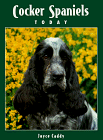
The Cocker Spaniel Today
Cocker Spaniels (also called English Cocker Spaniels) can be very good family dogs. They are not so big that they bowl children over, and the best cockers are friendly, outgoing and tolerant of children. They take to obedience training well, and enjoy a range of activities, including retrieving, flyball and agility. This breed is very trainable, so long as owners are gentle as well as firm, since Cocker Spaniels are generally sensitive dogs. They are sometimes a little slow to housetrain, and can put on weight easily. This may be because owners find it hard to resist cute spaniel eyes telling them it's cold outside, or pleading for another titbit. Fat little pups tend to turn into obese adults with associated health problems, so it's important not to believe a fat little pup who tries to convince you he is starving!
Historically, the Cocker spaniel has been one of the UK’s most popular breeds, based on kennel club registrations. Two types of cocker have evolved as the show world increasingly sought a more refined appearance, the competitive gundog world wanted more energy and drive and today it’s evident that there are two very distinct types.
The show cocker has a much longer and lower ear set than working, or pet cockers and is considerably taller. Their coats are also much longer than those of working cockers, because this trait is prized in the show world. They still tend to be more active than American cockers, because they have a shorter history as show dogs.
In 2012 the working cocker spaniel suddenly became recognised by the general public as a breed different from the cocker spaniel when Kate Middleton, Duchess of Cambridge and her new puppy Ludo made the tabloids. Previously, these were very much the type seen on the shoot, and less so in the family home. The working type is bred for functionality over looks and tends to have a much less domed head, is smaller and lighter in build and has shorter ears and lighter textured coat. They are also incredibly active little dogs. They are sometimes referred to as ‘pocket rockets’ and when watching them in action, it’s clear to see why.
Cocker Spaniels need a fair amount of grooming. They like going in muddy places and through undergrowth, where they pick up burrs and other debris. Some Cockers can also mat easily. Many owners have their Cockers trimmed to make grooming easier. They can also be quite barky dogs, which means they are good watchdogs, though they are too small to be good guard dogs. Cocker Spaniels are often a little nippy, and they do need extensive socialization with people, proper training and an active life to realise their potential. Part of the trouble, however, lies in their past popularity, which led some breeders to produce puppies with no thought for their temperament.The problem of Cocker 'rage' persists, though there has been a drive to eradicate this. Epilepsy is also all too common in Cockers. The two conditions seem to be related, with some dogs suffering from epilepsy also biting, and appearing dazed after the event. Often, though, Cockers are nippy simply because they are cute as little pups, and not enough effort is put into teaching them that biting people is unacceptable.
Other health problems that Cockers are vulnerable to include hypothyroidism, hip dysplasia, eye trouble, allergies, and ear trouble. Like all dogs with long ears Cocker Spaniels are prone to ear infections, especially if the ears get wet on walks, so it's important to dry them properly and protect them during baths. Hereditary deafness can also affect some Cockers, especially those of more than one colour.
Joyce Caddy's guide to Cocker Spaniels not only covers the usual breed history and general care, but also deals with cocker spaniels as gundogs. There is also an illustrated guide to grooming and trimming, and the cocker spaniel as a showdog, though anyone who just wants a Cocker to look cute and be well groomed could perhaps think again about whether their dog should be allowed to go out and get muddy, which is what this breed most loves to do!



